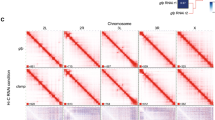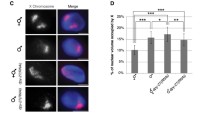Abstract
Dosage compensation in Drosophila is controlled by a complex (DCC) of proteins and noncoding RNA that binds specifically to the male X chromosome and leads to fine-tuning of transcription. Here, we employ male SL2 cells to characterize DCC function and dynamics during steady state of dosage compensation. Knocking down the key regulator of dosage compensation, male-specific-lethal 2 (MSL2), leads to loss of propagation of histone H4 lysine 16 acetylation and of the twofold elevation of transcription characteristic of the compensated male X chromosome. Surprisingly, lack of dosage compensation does not impair cell viability. Targeting of MSL2 to a reporter gene suffices to initiate dosage compensation in the cell model. Using photobleaching techniques in living cells, we found the association of MSL2 with the X chromosome to be exceptionally stable, essentially excluding dynamic redistribution of the DCC during interphase. This immobility distinguishes MSL2 from most other chromosomal proteins. Our findings have profound implications for the mechanism underlying dosage compensation and furthermore provide a new, conceptual reference of stability in an otherwise highly dynamic nuclear environment.








Similar content being viewed by others
References
Akhtar A, Becker PB (2000) Activation of transcription through histone H4 acetylation by MOF, an acetyltransferase essential for dosage compensation in Drosophila. Mol Cell 5:367–375
Akhtar A, Zink D, Becker PB (2000) Chromodomains are protein-RNA interaction modules. Nature 407:405–409
Becker M, Baumann C, John S, Walker DA, Vigneron M, McNally JG, Hager GL (2002) Dynamic behavior of transcription factors on a natural promoter in living cells. EMBO Rep 3:1188–1194
Belote JM, Lucchesi JC (1980) Male-specific lethal mutations of Drosophila melanogaster. Genetics 96:165–186
Birchler JA, Pal-Bhadra M, Bhadra U (2003) Dosage dependent gene regulation and the compensation of the X chromosome in Drosophila males. Genetica 117:179–190
Bone JR, Lavender J, Richman R, Palmer MJ, Turner BM, Kuroda MI (1994) Acetylated histone H4 on the male X chromosome is associated with dosage compensation in Drosophila. Genes Dev 8:96–104
Buchenau P, Hodgson J, Strutt H, Arndt-Jovin DJ (1998) The distribution of polycomb-group proteins during cell division and development in Drosophila embryos: impact on models for silencing. J Cell Biol 141:469–481
Buscaino A, Kocher T, Kind JH, Holz H, Taipale M, Wagner K, Wilm M, Akhtar A (2003) MOF-regulated acetylation of MSL-3 in the Drosophila dosage compensation complex. Mol Cell 11:1265–1277
Chen G, Nguyen PH, Courey AJ (1998) A role for Groucho tetramerization in transcriptional repression. Mol Cell Biol 18:7259–7268
Cheutin T, McNairn AJ, Jenuwein T, Gilbert DM, Singh PB, Misteli T (2003) Maintenance of stable heterochromatin domains by dynamic HP1 binding. Science 299:721–725
Chiang PW, Kurnit DM (2003) Study of dosage compensation in Drosophila. Genetics 165:1167–1181
Copps K, Richman R, Lyman LM, Chang KA, Rampersad-Ammons J, Kuroda MI (1998) Complex formation by the Drosophila MSL proteins: role of the MSL2 RING finger in protein complex assembly. EMBO J 17:5409–5417
Demakova OV, Kotlikova IV, Gordadze PR, Alekseyenko AA, Kuroda MI, Zhimulev IF (2003) The MSL complex levels are critical for its correct targeting to the chromosomes in Drosophila melanogaster. Chromosoma 112:103–115
Fagegaltier D, Baker BS (2004) X chromosome sites autonomously recruit the dosage compensation complex in Drosophila males. PLoS Biol 2:e341
Festenstein R, Pagakis SN, Hiragami K, Lyon D, Verreault A, Sekkali B, Kioussis D (2003) Modulation of heterochromatin protein 1 dynamics in primary mammalian cells. Science 299:719–721
Flores-Saaib RD, Jia S, Courey AJ (2001) Activation and repression by the C-terminal domain of dorsal. Development 128:1869–1879
Gilfillan GD, Dahlsveen IK, Becker PB (2004) Lifting a chromosome: dosage compensation in Drosophila melanogaster. FEBS Lett 567:8–14
Gu W, Wei X, Pannuti A, Lucchesi JC (2000) Targeting the chromatin-remodeling MSL complex of Drosophila to its sites of action on the X chromosome requires both acetyl transferase and ATPase activities. EMBO J 19:5202–5211
Henry RA, Tews B, Li X, Scott MJ (2001) Recruitment of the male-specific lethal (MSL) dosage compensation complex to an autosomally integrated roX chromatin entry site correlates with an increased expression of an adjacent reporter gene in male Drosophila. J Biol Chem 276:31953–31958
Jin Y, Wang Y, Johansen J, Johansen KM (2000) JIL-1, a chromosomal kinase implicated in regulation of chromatin structure, associates with the male specific lethal (MSL) dosage compensation complex. J Cell Biol 149:1005–1010
Kageyama Y, Mengus G, Gilfillan G, Kennedy HG, Stuckenholz C, Kelley RL, Becker PB, Kuroda MI (2001) Association and spreading of the Drosophila dosage compensation complex from a discrete roX1 chromatin entry site. EMBO J 20:2236–2245
Kelley RL, Meller VH, Gordadze PR, Roman G, Davis RL, Kuroda MI (1999) Epigenetic spreading of the Drosophila dosage compensation complex from roX RNA genes into flanking chromatin. Cell 98:513–522
Kimura H, Cook PR (2001) Kinetics of core histones in living human cells: little exchange of H3 and H4 and some rapid exchange of H2B. J Cell Biol 153:1341–1353
Lavender JS, Birley AJ, Palmer MJ, Kuroda MI, Turner BM (1994) Histone H4 acetylated at lysine 16 and proteins of the Drosophila dosage compensation pathway co-localize on the male X chromosome through mitosis. Chromosome Res 2:398–404
Lyman LM, Copps K, Rastelli L, Kelley RL, Kuroda MI (1997) Drosophila male-specific lethal-2 protein: structure/function analysis and dependence on MSL-1 for chromosome association. Genetics 147:1743–1753
Maiato H, Sunkel CE, Earnshaw WC (2003) Dissecting mitosis by RNAi in Drosophila tissue culture cells. Biol Proced Online 5:153–161
Maison C, Almouzni G (2004) HP1 and the dynamics of heterochromatin maintenance. Nat Rev Mol Cell Biol 5:296–304
Meller VH (2003) Initiation of dosage compensation in Drosophila embryos depends on expression of the roX RNAs. Mech Dev 120:759–767
Meller VH, Rattner BP (2002) The roX genes encode redundant male-specific lethal transcripts required for targeting of the MSL complex. EMBO J 21:1084–1091
Meller VH, Gordadze PR, Park Y, Chu X, Stuckenholz C, Kelley RL, Kuroda MI (2000) Ordered assembly of roX RNAs into MSL complexes on the dosage-compensated X chromosome in Drosophila. Curr Biol 10:136–143
Misteli T (2001) Protein dynamics: implications for nuclear architecture and gene expression. Science 291:843–847
Morales V, Straub T, Neumann MF, Mengus G, Akhtar A, Becker PB (2004) Functional integration of the histone acetyltransferase MOF into the dosage compensation complex. EMBO J 23:2258–2268
Murzina N, Verreault A, Laue E, Stillman B (1999) Heterochromatin dynamics in mouse cells: interaction between chromatin assembly factor 1 and HP1 proteins. Mol Cell 4:529–540
Nagai T, Ibata K, Park ES, Kubota M, Mikoshiba K, Miyawaki A (2002) A variant of yellow fluorescent protein with fast and efficient maturation for cell-biological applications. Nat Biotechnol 20:87–90
Oh H, Park Y, Kuroda MI (2003) Local spreading of MSL complexes from roX genes on the Drosophila X chromosome. Genes Dev 17:1334–1339
Oh H, Bone JR, Kuroda MI (2004) Multiple classes of MSL binding sites target dosage compensation to the X chromosome of Drosophila. Curr Biol 14:481–487
Park Y, Kelley RL, Oh H, Kuroda MI, Meller VH (2002) Extent of chromatin spreading determined by roX RNA recruitment of MSL proteins. Science 298:1620–1623
Phair RD, Misteli T (2000) High mobility of proteins in the mammalian cell nucleus. Nature 404:604–609
Phair RD, Scaffidi P, Elbi C, Vecerova J, Dey A, Ozato K, Brown DT, Hager G, Bustin M, Misteli T (2004) Global nature of dynamic protein–chromatin interactions in vivo: three-dimensional genome scanning and dynamic interaction networks of chromatin proteins. Mol Cell Biol 24:6393–6402
Rattner BP, Meller VH (2004) Drosophila male-specific lethal 2 protein controls sex-specific expression of the roX genes. Genetics 166:1825–1832
Ringrose L, Ehret H, Paro R (2004) Distinct contributions of histone H3 lysine 9 and 27 methylation to locus-specific stability of polycomb complexes. Mol Cell 16:641–653
Sass GL, Pannuti A, Lucchesi JC (2003) Male-specific lethal complex of Drosophila targets activated regions of the X chromosome for chromatin remodeling. Proc Natl Acad Sci U S A 100:8287–8291
Schmiedeberg L, Weisshart K, Diekmann S, Meyer Zu Hoerste G, Hemmerich P (2004) High- and low-mobility populations of HP1 in heterochromatin of mammalian cells. Mol Biol Cell 15:2819–2833
Simon JA, Tamkun JW (2002) Programming off and on states in chromatin: mechanisms of polycomb and trithorax group complexes. Curr Opin Genet Dev 12:210–218
Smith ER, Pannuti A, Gu W, Steurnagel A, Cook RG, Allis CD, Lucchesi JC (2000) The Drosophila MSL complex acetylates histone H4 at lysine 16, a chromatin modification linked to dosage compensation. Mol Cell Biol 20:312–318
Smothers JF, Henikoff S (2001) The hinge and chromo shadow domain impart distinct targeting of HP1-like proteins. Mol Cell Biol 21:2555–2569
Sporbert A, Gahl A, Ankerhold R, Leonhardt H, Cardoso MC (2002) DNA polymerase clamp shows little turnover at established replication sites but sequential de novo assembly at adjacent origin clusters. Mol Cell 10:1355–1365
Spradling AC, Rubin GM (1982) Transposition of cloned P elements into Drosophila germ line chromosomes. Science 218:341–347
Steller H, Pirrotta V (1985) A transposable P vector that confers selectable G418 resistance to Drosophila larvae. EMBO J 4:167–171
Straub T, Dahlsveen IK, Becker PB (2005) Dosage compensation in flies: mechanism, models, mystery. FEBS Lett 579:3258–3263
Sullivan W, Ashburner M, Hawley A (2000) Mapping protein distributions on polytene chromosomes by immunostaining. In: Drosophila protocols. Cold Spring Harbor Laboratory Press, Cold Spring Harbor
White J, Stelzer E (1999) Photobleaching GFP reveals protein dynamics inside live cells. Trends Cell Biol 9:61–65
Zaidi SK, Young DW, Choi JY, Pratap J, Javed A, Montecino M, Stein JL, van Wijnen AJ, Lian JB, Stein GS (2005) The dynamic organization of gene-regulatory machinery in nuclear microenvironments. EMBO Rep 6:128–133
Zhou S, Yang Y, Scott MJ, Pannuti A, Fehr KC, Eisen A, Koonin EV, Fouts DL, Wrightsman R, Manning JE et al (1995) Male-specific lethal 2, a dosage compensation gene of Drosophila, undergoes sex-specific regulation and encodes a protein with a RING finger and a metallothionein-like cysteine cluster. EMBO J 14:2884–2895
Acknowledgements
We thank H. Mitlöhner and I. Vetter for excellent technical assistance, M. Kuroda for providing antibodies, D. Arndt-Jovin for the SF4 cell line, S. Henikoff for HP1α-GFP expression plasmid, and the Hans and Ilse Breuer Foundation for the Zeiss LSM510 confocal microscope. We are grateful to Cristina Cardoso, Fabio Spada, and members of the laboratory for critical reading of the manuscript and helpful discussions. This work was supported by the Deutsche Forschungsgemeinschaft through Transregio 5.
Author information
Authors and Affiliations
Corresponding author
Additional information
Communicated by E. A. Nigg
Straub and Neumann contributed equally to this work.
Electronic supplementary material
412_2005_20_MOESM1_ESM.mpg
Supplementary movie. MSL2–GFP remains bound to the X chromosome during mitosis. Bright-field and GFP-fluorescence images collected at the indicated time from an SF4 cell line stably expressing MSL2–GFP. Images were merged, time-stamped, and sequentially organized into a movie using NIH ImageJ (MPG 2.011 kb).
Rights and permissions
About this article
Cite this article
Straub, T., Neumann, M.F., Prestel, M. et al. Stable chromosomal association of MSL2 defines a dosage-compensated nuclear compartment. Chromosoma 114, 352–364 (2005). https://doi.org/10.1007/s00412-005-0020-x
Received:
Accepted:
Published:
Issue Date:
DOI: https://doi.org/10.1007/s00412-005-0020-x




